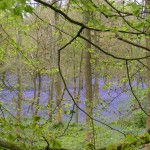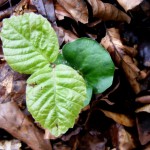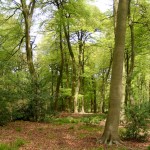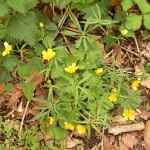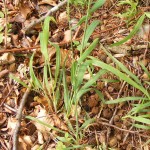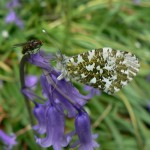On Sunday 27th April, Michael Keith-Lucas led a circular walk round the woods at the National Trust’s Greys Court at Rotherfield Greys. The Bluebells were at their best and large parts of the woods were carpeted in blue. Close to the start of the walk was a flowering Horse Chestnut tree. Michael pointed out that what look from a distance like white flowers actually also have coloured spots, which are yellow for flowers which have not yet been pollinated and red for pollinated flowers. Bees only visit the flowers with yellow spots. The walk continued up to the woods on the top of the ridge, where the new leaves on the Beech trees were bright green. Michael explained how the underlying geology can be read from the vegetation beneath the Beech trees: Dog’s Mercury on alkaline soil, bramble and Holly on neutral to mildly acid soil, as was the case here on clay with flints, and bare soil in more strongly acid conditions. The male flowers of Beech trees are very susceptible to frost and in our area, Beech mast is produced on average only about once every five years. 2013 must have been a good mast year, because new Beech seedlings were plentiful in the shadier parts of the wood. In contrast, the Ash seedlings were doing best in the lighter areas. In the woods were both large pits, from which flints or chalk had been extracted, and smaller pits, marking the root-plates of fallen trees. Beside the path were tufts of Southern Wood-rush and Compact Rush. Michael showed how the leaves of Wood Millet turn over at the base, exposing the stomata on the top surface. This enhances evaporation and increases the flow of water and nutrients through the plant – a strategy which would be too risky in a sunnier location. Clumps of Goldilocks Buttercup, with sparse petals, were also seen.
The path began to drop down the side of the dry valley and Michael pointed out the geological boundary as the Holly and brambles came to an abrupt halt and Dog’s Mercury began, marking out the transition onto the Chalk. The Dog’s Mercury plants spread by underground rhizomes, so they are found in clumps of genetically-identical individuals. The male plants have brighter green and narrower leaves and tend to grow in lighter areas close to the path. The female plants have broader, darker blue-green leaves and tend to grow in shadier places. Other base-loving plants on the chalk included Old Man’s Beard and Spurge-Laurel. Yellow Archangel, Bush Vetch and Wild Strawberry were amongst the flowers seen as the path continued along the side of the valley. An Orange-tip butterfly was roosting with closed wings on a Bluebell flower, showing the dappled yellow-green markings on its underside.
Pictures by Rob Stallard and Laurie Haseler
RDNHS excursion Greys Court Estate, 27-4-2014
Plant species:
| Acer pseudoplatanus | Sycamore |
| Aesculus hippocastanum | Horse Chestnut |
| Ajuga reptans | Bugle |
| Alliaria petiolata | Garlic Mustard |
| Arum maculatum | Lords-and-Ladies |
| Circaea lutetiana | Enchanter’s-nightshade |
| Clematis vitalba | Traveller’s-joy |
| Daphne laureola | Spurge- laurel (SU719838) |
| Erodium cicutarium | Common Stork’s-bill |
| Euphorbia amygdaloides | Wood Spurge |
| Fagus sylvatica | Beech (flowering trees and seedlings) |
| Fragaria vesca | Wild Strawberry |
| Fraxinus excelsior | Ash |
| Galium aparine (leaves) | Cleavers |
| Galium odoratum | Woodruff |
| Geranium robertianum | Herb-Robert |
| Geum urbanum | Wood Avens |
| Glechoma hederacea | Ground-ivy |
| Hyacinthoides non-scripta | Bluebell |
| Juncus conglomeratus | Compact Rush |
| Lamiastrum galeobdolon | Yellow Archangel |
| Lamium album | White Dead-nettle |
| Lamium purpureum | Red Dead-nettle |
| Lonicera periclymenum (leaves) | Honeysuckle |
| Luzula forsteri | Southern Wood-rush |
| Mercurialis perennis | Dog’s Mercury (alkaline soil indicator) |
| Milium effusum | Wood Millet (characteristic grass for the Chilterns) |
| Myosotis arvensis | Field Forget-me-not |
| Potentilla sterilis | Barren Strawberry |
| Ranunculus auricomus | Goldilocks Buttercup |
| Ranunculus ficaria | Lesser Celandine |
| Ribes uva-crispa | Gooseberry |
| Rubus fruticosus | Bramble |
| Sambucus nigra | Elder |
| Stachys sylvatica | Hedge Woundwort |
| Stellaria holostea | Greater Stitchwort |
| Taraxacum officinale | Dandelion |
| Thuja plicata | Western Red-cedar |
| Veronica chamaedrys | Germander Speedwell |
| Veronica montana | Wood speedwell |
| Vicia sepium | Bush Vetch |
| Urtica dioica (leaves) | Common Nettle |
Birds:
| Milvus milvus | Red Kite |
| Phasianus colchicus | Pheasant |
| Phylloscopus collybita | Chiffchaff |
List by Renée Grayer

